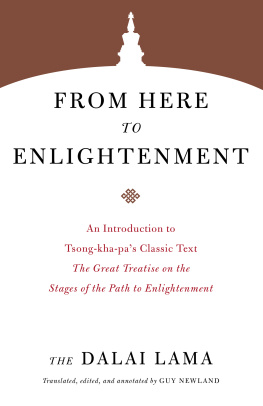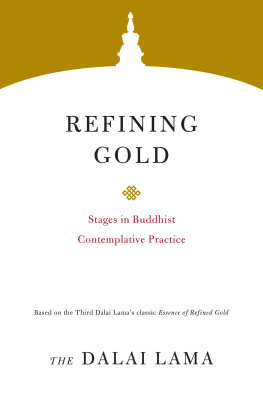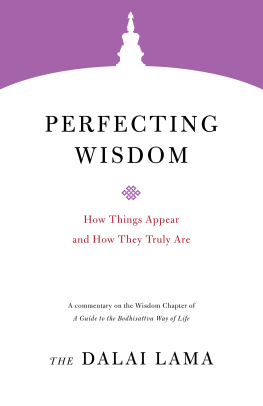Contents
Landmarks
Print Page List
Shambhala Publications, Inc.
4720 Walnut Street
Boulder, Colorado 80301
www.shambhala.com
1988, 1994, 2009 by His Holiness the Dalai Lama and B. Alan Wallace
This book was previously published under the title Transcendent Wisdom.
All rights reserved. No part of this book may be reproduced in any form or by any means, electronic or mechanical, including photocopying, recording, or by any information storage and retrieval system, without permission in writing from the publisher.
Cover design by Claudine Mansour Design
Library of Congress Cataloging-in-Publication Data
Names: Bstan-dzin-rgya-mtsho, Dalai Lama xiv, 1935 author. |
Wallace, B. Alan, translator, editor.
Title: Perfecting wisdom: how things appear and how they truly are / the Dalai Lama; translated, edited, and annotated by B. Alan Wallace. Other titles: Transcendent wisdom
Description: Boulder: Shambhala, 2019. | Series: Core teachings of the Dalai Lama | This book was previously published under the title Transcendent Wisdom. | Includes bibliographical references and index.
Identifiers: LCCN 2018052883 | ISBN 9781611807349 (pbk.: alk. paper)
eISBN 9780834842304
Subjects: LCSH: ntideva, active 7th century. Bodhicaryvatra. Chapter 9. | Mahayana BuddhismDoctrines. | WisdomReligious aspectsBuddhism.
Classification: LCC BQ3147.T73 2019 | DDC 294.3/420423dc23
LC record available at https://lccn.loc.gov/2018052883
v5.4
a
C ONTENTS

F OREWORD

T HIS WORK CONSISTS of a translation from the Sanskrit of the ninth chapter of a work entitled A Guide to the Bodhisattva Way of Life This chapter, named Transcendent Wisdom, sets forth the Centrist, or Madhyamika view of Buddhist philosophy in the context of other Buddhist and non-Buddhist views. From a Western perspective it is philosophical in content; yet it has a definite religious tone to it, and it also belongs to a contemplative discipline that presents empirical means for testing its conclusions.
The translation of this text has been made primarily on the basis of a commentary in classical Tibetan by the fourteenth-century Tibetan master Tsongkhapa. This commentary was delivered before an assembly of roughly a thousand Tibetans and a few score Westerners, and it clearly assumes some background in Buddhist philosophy on the part of the listeners. The Transcendent Wisdom chapter of Shantidevas classic treatise is known among Buddhist scholars as a challenging and profound exposition of the pinnacle of Buddhist philosophy. Hopefully this translation will further elucidate this text for those seeking an understanding of the Buddhist Centrist view and its relevance to contemporary thought.
A CKNOWLEDGMENTS

T HIS TRANSLATION WAS completed during my years of study at Amherst College, culminating in December 1986. I am particularly grateful to Robert Thurman, then professor of religion at Amherst College, for his careful reading of the text and commentary. I would also like to thank Vesna Acimovic for her corrections of the Sanskrit translation.
While making the initial translation of the Sanskrit text, I used the version edited by P. L. Vaidya (Buddhist Sanskrit Text Series). I also consulted the Tibetan translation published by the Tibetan Cultural Printing Press in Dharamsala, India, and Stephen Batchelors English translation of the text. While working on later drafts, I consulted Michael Sweets translation in his 1977 doctoral dissertation in Buddhist studies at the University of Wisconsin, entitled ntideva and the Mdhyamika: The Prajpramit-Pariccheda of the Bodhicryvatra.
I NTRODUCTION
The Place of Wisdom in Spiritual Practice

1. This entire preparation the Sage taught for the sake of wisdom. Thus, one wishing to bring an end to suffering should develop wisdom.
This entire preparation refers to the first five transcendent practices of generosity and so on,
What is the nature of wisdom? The view of emptiness entailing the integration of meditative quiescence The major obstacles to the attainment of full spiritual awakening are the cognitive obscurations. Ultimate wisdom is their direct antidote. To cultivate that, this series of practices must be followed, thereby accumulating great virtue. Thus it is said: This entire preparation the Sage taught for the sake of wisdom. Thus, one who wishes to bring an end to the suffering of oneself and others should develop such wisdom.
There are no teachings of the Buddha that are not means for living creatures to attain prosperity are eliminated. All those methods were taught for the sake of liberation.
PART ONE

T HE M ETHODS N EEDED FOR C ULTIVATING W ISDOM
1. I NTRODUCTION TO THE T WO T RUTHS THAT C OMPRISE R EALITY

T HE C LASSIFICATION OF THE T WO T RUTHS
2. The twofold truth is considered to be conventional and ultimate. [Ultimate] reality is not an object of the intellect; the intellect is called conventional.
There are many types of wisdom relating to the plurality of phenomena for such grasping, which are cognitive obscurations. Such wisdom is the view by which one realizes emptiness; one thereby knows the fundamental nature of reality.
We need to understand the essential nature of the broad diversity of phenomena. For example, if we are obliged to be involved frequently with a man who exhibits a personality that is true only on the surface, as well as another basic personality, it is important for us to know both of them. To engage in a relationship with this person that does not go awry, we must know both aspects of his personality. To know only the facade that he presents is insufficient; we need to know his basic disposition and abilities. Then we can know what to expect from him, and he will not deceive us.
Likewise, the manifold events in the world are not non-existent; they do exist. They are able to help and hurt usno further criterion for existence is necessary. If we do not understand their fundamental mode of existence, we are liable to be deceived, just as in the case of being involved with a person whose basic personality we do not know.




















